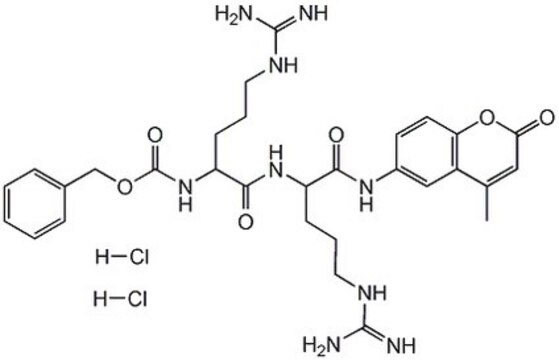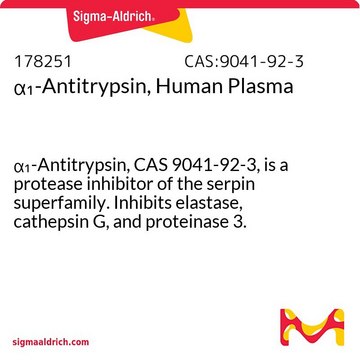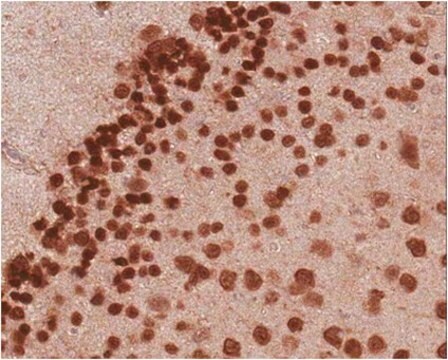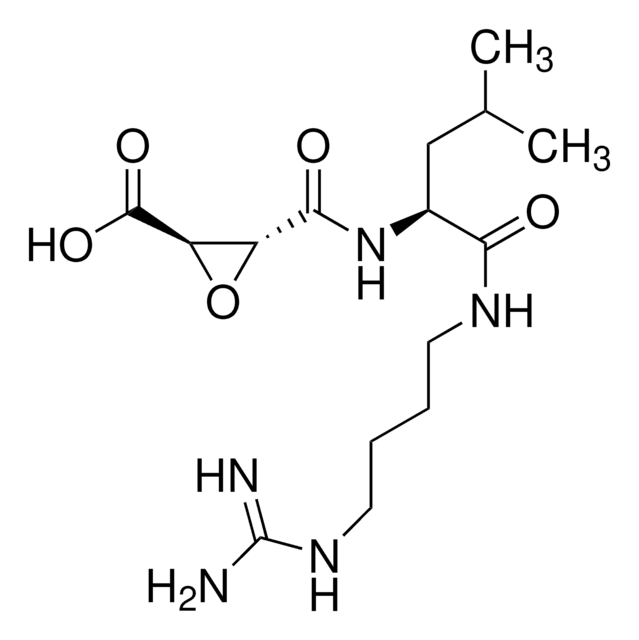Allgemeine Beschreibung
A highly sensitive and selective fluorogenic assay for the detection of Cathepsin L from human and mouse samples. Cathepsin L is detected with the fluorogenic substrate Z-Phe-Arg-AMC (Exc. max: 360 nm; Emi. max: 460 nm). Interference from Cathepsin B is eliminated by the incorporation of CA 074, a specific cathepsin B inhibitor. This kit is also useful for screening cathepsin L inhibitors.
Komponenten
Cathepsin L Substrate, AMC Calibration Standard, Cathepsin L Control, Cathepsin L Activator, CA 074, Cathepsin L Inhibitor, Assay Buffer, Sample Buffer, Diluent, Microwell Plate, Plate Sealer, and a user protocol.
Warnhinweis
Toxicity: Multiple Toxicity Values, refer to MSDS (O)
Spezifikationen
Assay Time: 1.5 - 2 h
Prinzip
The Calbiochem InnoZyme Cathepsin L Activity Kit, Fluorogenic is suited for measuring Cathepsin L activity using purified preparations, cell lysates, and tissue extracts, and for screening Cathepsin L inhibitors. This assay does not measure Cathepsin B activity.
Angaben zur Herstellung
All reagents necessary to perform the assay are supplied with this kit. Bring all reagents, except the Cathepsin L Control (see below), to room temperature prior to use.• AMC Calibration Standard: The AMC Calibration Standard is supplied as a 2 mM stock solution. The recommended concentration range for generating a calibration curve is 0.156-20 µM. Prepare serial dilutions of the Calibration AMC Standard as indicated in the table below. Vortex each dilution prior to transfer, taking care to change the pipet tip for each dilution.• Cathepsin L Control: Prepare desired number of Cathepsin L Control samples by diluting the Cathepsin L Control (10 µg/ml stock) with Sample Buffer, within the range of 1.56-100 ng/ml. Typically 0.078-5 ng/50 µl is recommended. Thaw and prepare diluted Cathepsin L Control just prior to use. Dispense the remaining Cathepsin L Control into aliquots and freeze at -70°C.• Activation Buffer: For measuring Cathepsin L activity in biological samples, prepare enough Activation Buffer for 50 µl/well. Dilute Reduction Reagent 1:125 and CA 074 Inhibitor 1:100 in Assay Buffer. Example: to prepare 1 ml of Activation Buffer, enough for a 16-well strip, add 10 µl CA 074 Inhibitor and 8 µl Reduction Reagent to 982 µl Assay Buffer.Note: to prepare Activation Buffer for Cathepsin L inhibitor screening do not add CA 074 Inhibitor to the Activation Buffer; add only Reduction Reagent.• Cathepsin L Inhibitor Working Solution (1X): Dilute Cathepsin L Inhibitor 1:100 with Diluent. Example: to prepare 1 ml Cathepsin L Inhibitor Working Solution, enough for a 16-well strip, add 10 µl Cathepsin L Inhibitor to 990 µl Diluent.• Substrate Working Solution (1X): Dilute the Substrate (10 mM) 1:100 with Diluent. Example: to prepare 1 ml Substrate Working Solution, enough for a 16-well strip, add 10 µl Substrate to 990 µl Diluent.• Test Inhibitor: Dilute any Test Inhibitors to the desired concentration with Diluent in a final volume of 50 µl.
• Biological Samples (e.g. crude extracts): Dilute samples, as necessary, using Sample Buffer. Typically, 10-200 µg protein/50 µl is recommended. • Purified Cathepsin L Sample: Dilute purified Cathepsin L, as necessary, using Sample Buffer. Typically, 10-100 ng/ml of enzyme is recommended.
Lagerung und Haltbarkeit
Upon arrival store the Cathepsin L Control at -70°C; store all other unopened components at -20°C. Upon initial use of the kit, the components may be stored for up to 3 months under the following conditions:
Store at 4°C: Assay Buffer, Sample Buffer Diluent, 96-Well Plate, and Plate Sealers
Store at -20°C: AMC Calibration Standard, CA 074 Inhibitor, Cathepsin L Inhibitor Substrate, and Reduction Reagent
Store at -70°C: Cathepsin L Control: dispense into aliquots upon initial use; avoid freeze/thaw cycles
Hinweis zur Analyse
Assay with AMC Calibration:It is recommended that the data be handled by a software package utilizing a linear regression curve-fitting program. If a software package is not available, construct a standard curve by plotting the mean fluorescence in relative fluorescence units (RFU), for each standard on the Y-axis versus the corresponding concentration of AMC on the X-axis and draw a best-fit curve through the points on the graph. A. Final RFU for Cathepsin L Sample with CA074 = (Crude (initial) RFU value for Cathepsin L Sample with CA074) - (RFU of Blank)B. Final RFU for Cathepsin L Sample with CA074 and cathepsin L inhibitor = (Crude RFU for Cathepsin L Sample with CA 074 and cathepsin L inhibitor) - (RFU of Blank)C. Corrected RFU for Cathepsin L sample = Final RFU from A - Final RFU from BThe Cathepsin L activity of unknown samples, using the final RFU, can be interpolated from the standard curve and displayed as an amount of free AMC released/mg protein in a specified time period.Assay without AMC Calibration:All biological samples should be assayed in duplicate and in parallel with two different conditions, in the presence of both CA 074 Inhibitor and Cathepsin L Inhibitor and in the presence of CA 074 Inhibitor alone. The initial Cathepsin L activity, displayed as RFU, is calculated by subtracting the RFU value for CA 074 Inhibitor + Cathepsin L Inhibitor from the RFU value for CA 074 Inhibitor only. The final Cathepsin L activity in each sample is displayed in RFU and is derived by subtracting the value of the blank from the initial RFU and then calculating the mean fluorescence value for duplicate samples. If the samples were diluted, the final Cathepsin L activity, as calculated above, is multiplied by the dilution factor to obtain the final Cathepsin L activity.
Positive Control
Cathepsin L
The working range of the assay, as determined using highly purified Cathepsin L, is between 1.56-100 ng/ml or 0.078-5 ng/assay.
Sonstige Hinweise
Bohne, S., et al. 2004. J. Pathol.203, 528.
Goulet, B., et al. 2004. Mol. Cell 14, 207.
Hook, V., et al. 2004. Biol. Chem. 385, 473.
Potts, W., et al. 2004. Int. J. Exp. Pathol. 85, 85.
Rousselet, N., et al. 2004. Cancer Res. 64, 146.
Schedel, J., et al. 2004. Gene Ther. 11, 1040.
Troy, A.M. et al. 2004. Eur. J. Cancer 40, 1610.
Corella, R., and Casey, S.F. 2003. Biotech. Histochem. 78, 101.
Ohashi, K., et al. 2003. Biochim. Biophys. Acta 1649, 30.
Friedrich, B., et al. 1999. Eur. J. Cancer 35, 138.
Cresswell P., 1998. Science 280, 394.
Yasuma, T., et al. 1998. J. Med. Chem. 41, 4301.
Kirschke, H. et al. 1982. Biochem. J. 201, 367.
Due to the nature of the Hazardous Materials in this shipment, additional shipping charges may be applied to your order. Certain sizes may be exempt from the additional hazardous materials shipping charges. Please contact your local sales office for more information regarding these charges.
Rechtliche Hinweise
CALBIOCHEM is a registered trademark of Merck KGaA, Darmstadt, Germany









